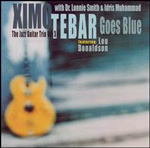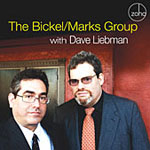Home » Jazz Articles » Interview » Ximo Tebar: Merging Sounds Into a Jazz Style
Ximo Tebar: Merging Sounds Into a Jazz Style

 Musician, producer and director of his own music school, Ximo Tebar stands out as the main jazz figure in Valencia, Spain. His music and talent, however, have also given him an international stature as an excellent guitarist and composer. His frequent collaborations with some of the finest musicians in the jazz scene, the stylistic variety of his recording and his admirable work capacity make Tebar an artist worth following.
Musician, producer and director of his own music school, Ximo Tebar stands out as the main jazz figure in Valencia, Spain. His music and talent, however, have also given him an international stature as an excellent guitarist and composer. His frequent collaborations with some of the finest musicians in the jazz scene, the stylistic variety of his recording and his admirable work capacity make Tebar an artist worth following. His recordings can be divided in two categories: those focused on fusion jazz, played with fairly of large ensembles where Tebar works hard on arrangements and textures; and others, where he concentrates on more orthodox jazz, normally playing in a trio, where fascinating interaction between musicians as well as impressive lead abilities can be heard.
Celebrating Erik Satie (Omix Records, 2010), is devoted to classical music composer Erik Satie. In Victor L.Shermer's words for AllAboutJazz.com: "The watchword of this album is 'plays,' with the implications of irony and humor, tinged with Chaplin-esque sadness that characterizes what Tebar and his ensemble, taking a cue from Satie, offer."
All About Jazz: You started to play music when you were seven. What made you go for the guitar?
Ximo Tebar: It happened by chance. My parents bought me a guitar in an attempt to stop me biting my nails.
AAJ: Undoubtedly, the guitar has been the main instrument in the development of styles such as rock 'n' roll. However, in jazz, even after becoming a lead instrument, it seems that it has a secondary position compared to wind instruments.
XT: Well, originally the guitar used to be part of the accompaniment; it was part of the rhythm section. Currently, it's a lead instrument, with the special characteristic that it can also be used as part of the rhythmic base, just like piano.
AAJ: In your latest record, you adapt classical compositions to a jazz language. How did the idea come up and how did you face the challenge?
XT: I love listening to classical music and also to study and analyze it. I'm not an expert, but I don't forget that classical music is the mother of all things in terms of composition, harmony and orchestration.
Erik Satie's music has always captivated me. Then, it all started with a proposition of the Valencian Music Institute (Instituto Valenciano de la Música) to make a record and a concert in the Jazz Festival in Xàbia. I decided to develop the idea of recording Satie's music in a jazz style. One of the things I most like is to play around with the music of other composers, make my own versions, reharmonize, put a twist on them, make arrangements, producing...
AAJ: We tend to get repeated the same information about Erik Satie: the difficulty of classifying his music and his peculiar character. What makes him different to other composers?
XT: Well, it seems that he was a very peculiar guy. His personality went beyond his own music and he became an intellectual figure of his time. Both his person and his music were eccentric, transgressive and daring.
The challenge and aim I've looked for with this project is to communicate, through music, one particular vision of Satie's work, based on the aspects of his personality: risk, dare, boldness, avant-garde, fusion, freedom; in other words, based on his vision of the world.
AAJ: History places the birth of jazz in the south of the United States, in cities like New Orleans. In your last record you've adapted classical music of a 19th century composer. How can we understand this duality between black music and European classical music ?
XT: In my opinion, nowadays music is not classified in genres, styles or geographical places anymore. Any creative idea comes from global and historic knowledge and influence from all the music that has existed on the planet, from Bach to Herbie Hancock, to Bob Marley, The Beatles, Louis Armstrong, Arnold Schoenberg, John Coltrane, Mozart, Camarón, Paco de Lucía... It is challenging to try to merge all those musical influences together from your own point of view and creativity. It's fascinating.
AAJ: So where does current jazz get its inspiration from?
XT: From different kinds of music and cultures.
 AAJ: As a musician and producer, what are the possibilities of creating a strong local jazz scene in Valencia? Which way should we follow?
AAJ: As a musician and producer, what are the possibilities of creating a strong local jazz scene in Valencia? Which way should we follow? XT: Education at schools, not only for jazz but for music in general. Music should be a compulsory subject in primary schools because it implies many important things that help with development and values of the individual: discipline, study, group work, overcoming, concentration, improvisation, creativity.
AAJ: You have gone through different music styles in records like Ximo Tebar Goes Blue (Omix Records, 2001) or Son Mediterráneo (WEA,1995) and now Celebrating Erik Satie. There are many artists that choose a particular style and focus on it. In your case, why do we get such a stylistic variety?
XT: Well, that's because I like many different types of music and depending on each moment I feel like doing something different.
 AAJ: A common characteristic in your recordings is the presence of the organ. You've counted on the collaboration of some of the finest organ players such as Lou Bennett, Dr. Lonnie Smith, and Joey DeFrancesco. What does the sound of the organ bring to your music?
AAJ: A common characteristic in your recordings is the presence of the organ. You've counted on the collaboration of some of the finest organ players such as Lou Bennett, Dr. Lonnie Smith, and Joey DeFrancesco. What does the sound of the organ bring to your music? XT: One of the standard jazz line-ups is the organ/guitar/drums trio. I am lucky to have been able to work regularly with some of the best jazz organists in the world. I owe that to Lou Bennet, with whom I worked as a musical director of his trio for ten years, going on tour and recording all around the world. Thanks to this collaboration I also had the opportunity to share stage and establish strong relationship with historic jazz musicians such as Benny Golson, Johnny Griffin, and George Benson.
AAJ: So you've played with many celebrated jazz musicians like the ones mentioned, and others like Lou Donaldson, Anthony Jackson, Tete Montoliu, and Louie Bellson. Do you have some special memory you'd like to share?
XT: Thanks to all the tours, gigs, recordings and shared life experience in rehearsals and trips (hours and hours by plane or car) I have drunk from the original source of the precious elixir of true jazz. They have never taught me a music class.
AAJ: About a month ago you played with Raimundo Amador, by the IVAM (Modern Art Valencian Institute). How was the experience? Did you have the chance to rehearse?
XT: Raimundo is an accomplished musician. I learned a lot spending time and playing with him. He's a great person and he's very involved in music and the values it stands for. With Raimundo, as well as with other great musicians there's no need to rehearse in order to get on stage. We get on to play and at that moment something beautiful and interesting is created. In my opinion, that's the greatness and definition of jazz; the capacity of creating depending on what's going on at each moment.
AAJ: After reading many headlines and articles, both from national and international press, it seems you enjoy a prestigious position: you're respected both by colleagues and critics. What are your next goals?
XT: I've been into music many years, studying, playing gigs, collaborating in different projects, recording my records and producing other people's. I'm passionate about creating new projects and setting new aims and objectives. Currently I'm involved in an interesting and original project that we're carrying out in the IVAM. It's an attractive initiative that continuously promotes creation and experimentation around jazz music. As an integrated part of the museum activities it widens the offer to other arts like avant-garde jazz. My aim is to keep working, and I would love to contribute to consolidating Valencia as a cultural focus, known for its innovation and modernity. Also, making easier the integration of new social groups from different cultures through music, and giving support to cross-cultural interaction.
Selected Discography
Ximo Tebar, Celebrating Erik Satie (Xabia Jazz, 2009)
Ximo Tebar, Steps (Omix Records, 2008)
Ximo Tebar, Eclipse (Omix Records, 2006)
Ximo Tebar, The Champs, The Jazz Guitar Trio, Vol.4 (Omix Records, 2004)
Ximo Tebar, Embrujado (Omix Records, 2003)
Ximo Tebar, Goes Blue, The Jazz Guitar Trio, Vol.3 (Omix Records, 2001)
Ximo Tebar, So What!, The Jazz Guitar Trio, Vol.2 (WEA, 1997)
Ximo Tebar, Hello Mr. Bennet, The Jazz Guitar Trio, Vol.1 (WEA, 1997)
Ximo Tebar, Son Mediterráneo (WEA, 1995)
Ximo Tebar, Te Kiero Con K (Omix Records, 2002)
Ximo Tebar, Live in Russia (1991)
Photo Credit
Josep Pedro
Tags
Ximo Tebar
Interview
Josep Pedro
Herbie Hancock
The Beatles
Louis Armstrong
John Coltrane
Lou Bennet
Dr. Lonnie Smith
Joey DeFrancesco
benny golson
Johnny Griffin
george benson
Lou Donaldson
Anthony Jackson
Tete Montoliu
Louie Bellson
PREVIOUS / NEXT
Support All About Jazz
 All About Jazz has been a pillar of jazz since 1995, championing it as an art form and, more importantly, supporting the musicians who make it. Our enduring commitment has made "AAJ" one of the most culturally important websites of its kind, read by hundreds of thousands of fans, musicians and industry figures every month.
All About Jazz has been a pillar of jazz since 1995, championing it as an art form and, more importantly, supporting the musicians who make it. Our enduring commitment has made "AAJ" one of the most culturally important websites of its kind, read by hundreds of thousands of fans, musicians and industry figures every month.





















